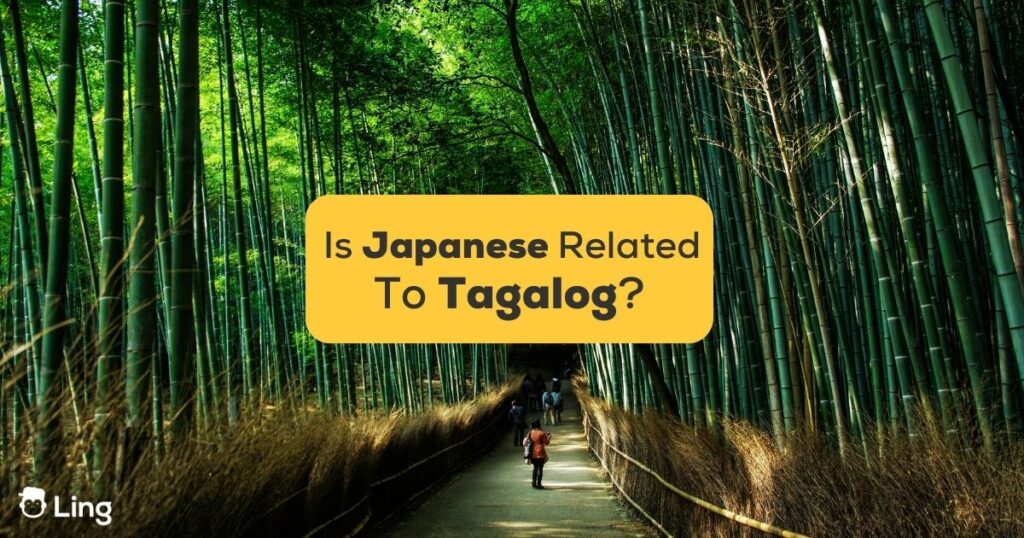Do you smell that, language aficionados? That’s the dynamic mix of sushi and adobo in the air as we dive headlong into an exciting exploration: Is Japanese related to Tagalog? Sure, Japan and the Philippines share some geographical proximity, but do their languages, Japanese and Tagalog, share a familial bond, or are they like two parallel lines—close but never touching? Let’s hit the beats on this linguistic rhyme and uncover the story!
The Japanese Language
Picture this: You’re traversing the bustling streets of Tokyo, cherry blossoms spilling their beauty overhead, and the delicate syllables of spoken Japanese enveloping your ears like silk. But what is the Japanese language, and what makes it more captivating than a haiku penned by a master poet? Let’s find out in this section!
The Japanese language—a unique tapestry woven from the Japonic language family—boasts more than 125 million speakers. With its intricate layers of formality, it’s a linguistic stratification that would leave any passionate observer in awe, like a hierarchical cake of communication!
And let’s not forget the writing! Combining not one, not two, but three systems—kanji, hiragana, and katakana—Japanese scripts intermingle like harmonious notes in a symphony of visual expression. Is it any wonder that fans of this linguistic melange are utterly smitten?
When it comes to Japanese grammar, brace yourselves for a ride more rollercoaster than a stroll through a zen garden. Subject-object-verb is the name of the game, leaving speakers to revel in a dance that places the verb at the end and sends the subject flying! Don’t worry, though—once you master it, conversational acrobatics will become second nature.
Lastly, the pièce de résistance: politeness. Japanese is like a carefully choreographed ballet, where words bow and pirouette gracefully to show respect, humility, and honor. Keigo, the art of humble and respectful speech, becomes the linguistic conductor, ensuring every spoken word treads lightly and considerately.

The Tagalog Language
Tagalog is like the Adobo of languages—a vibrant mix of local flavor with international influences. Belonging to the Malayo-Polynesian branch of the Austronesian language family, it distinctly swings to its own rhythm in the Pacific.
Home to over 28 million native speakers, Tagalog is, without a doubt, the Philippines’ superstar language. With its fascinating blend of indigenous and borrowed words (hello, Spanish and English), Tagalog is a language fiesta capable of dishing out heartwarming ‘salamat’ (thanks) and enthusiastic ‘kumusta’ (hello)!
The Tagalog script—Baybayin—is an art form in itself, reserved today for artistic applications. But don’t worry if you’re not a Picasso, modern Tagalog is typically written in the Latin script. A balancing act between the local and global, just like the Philippines itself!
As for the grammar, Tagalog dances to an unexpected beat—Subject-Verb-Object? Not in this linguistic party! Instead, it struts to the tune of ‘verbs-first’. This involves the verb leading the sentence, with the rest of the party—subject and object—following suit. So, dust off your dancing shoes, it’s time for a new routine!

Is Japanese Related To Tagalog?
Japanese and Tagalog are languages that, like a sushi roll and a lechón, may seem similar on the surface but are fundamentally different. They belong to separate linguistic families: Japanese is part of the Japonic family, and Tagalog hails from the Malayo-Polynesian branch of the Austronesian family.
To put it simply, if linguistic families were airlines, Japanese and Tagalog would be flying from different terminals. But wait—what about any layovers or pit stops? Some linguistic luggage was indeed exchanged between these two cultures.
The Philippines and Japan have been trading partners and have had cultural exchanges for centuries. It’s no surprise that some words have hopped onto this intercultural exchange. Tagalog has adopted words like ‘hapon’ from Nihon, meaning Japan or late afternoon, and ‘katana’—a type of sword traditionally used by samurais.
However, these borrowed nuggets of language, akin to souvenirs from a foreign land, don’t necessarily imply a direct ancestral linkage—more of an influence exchange. Liken it to you picking up a fondness for croissants after a trip to France—it doesn’t make you French, just appreciative of buttery goodness!
So, as we tie up our linguistic exploration, it’s clear that while Japanese and Tagalog may have interacted, they dance to different linguistic tunes. Kind of like recognizable steps in an international dance-off, they bear some resemblance but come with their distinct flair!
Learn Japanese With Ling
And there you have it, folks—the epic linguistic encounter: Japanese vs. Tagalog settled! From the poetic contours of Japanese to the rhythmic heartbeats of Tagalog, it’s clear that while these languages might pass each other on the globe’s highway, they each take a unique turn on the language map. And we, the linguistic explorers, zip around in our proverbial hovercars, getting a delightful taste of both worlds!
But hey, don’t let your linguistic journey end here! Thirsty to brew your own Japanese sentences and savor the authentic taste of Nippon phrases? Wait no more! It’s time to turbocharge your language learning journey with the Ling app.
Like a well-versed sensei, Ling is here to guide you, offering tailored lessons that will have you busting out Japanese quicker than a sushi chef slices sashimi. Whether you dream of conjuring haikus under a sakura tree or ordering ramen like a local, Ling is your ticket to linguistic mastery!
Ready to strap on your learning gear and conquer Japanese? Whisk out your smartphones and download Ling from the App Store or Play Store today.



































































